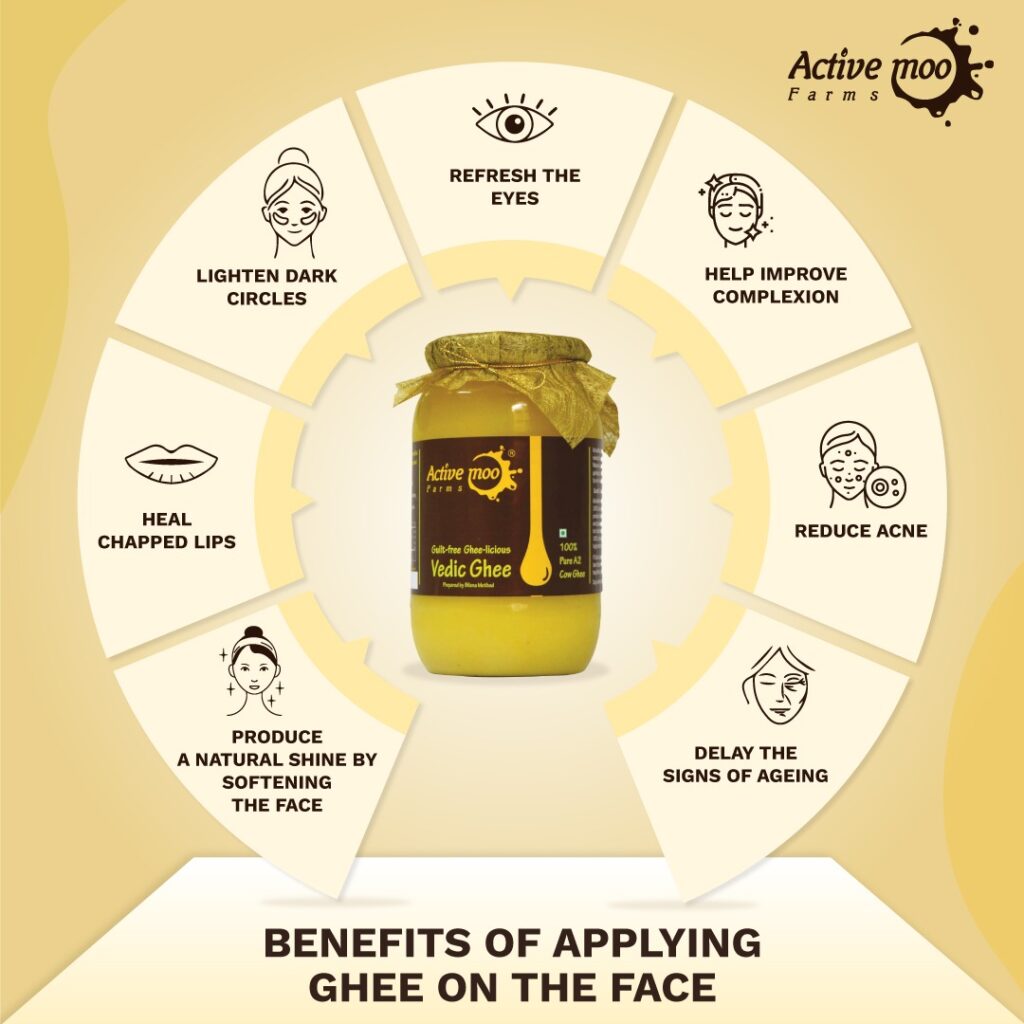When I was younger, my mother would always apply a layer of ghee to my lips before sending me out to school in the harsh winter months. She claimed that using ghee for skin would protect my skin from the harsh weather. And she was right – I never got chapped lips or skin irritation.
Even now, as an adult, I continue this tradition and it still works like a charm. Every winter, I apply a layer of ghee on my lips and they stay soft and healthy all season long. It’s a tradition I don’t want to miss. Our family has been using cow ghee for years to reap all the health and skin benefits. Do you want to know the benefits of ghee for your skin? Let’s explore how ghee can be beneficial for your skin’s health.
What is Ghee?
Ghee is another name for clarified butter. The most prevalent type is semi-liquid with a mushy texture and high nutritional value. The inclusion of beta-carotene pigment gives it its yellowish colour.
Ghee is an Indian Golden Elixir. Ghee has been used in healing and cooking for centuries. It is historically used to massage pregnant women and newborn infants.
Is Ghee Beneficial for Skin?
Ghee has been used in ayurvedic medicine for centuries and is known for its nourishing and healing properties. Recent studies have shown that ghee can be beneficial for the skin, both when ingested and when applied topically. The various benefits of ghee for skin can include:
- Ghee is packed with vitamins A, E and K, which are known to be beneficial for the skin.
- When ingested, ghee helps to moisturise the skin from within, keeping it supple and glowing.
- When applied topically, ghee can help to heal wounds and protect the skin from environmental aggressors.
So, if you’re looking for a natural way to help your skin look and feel its best, try incorporating ghee into your beauty routine!
Ghee Use in Ayurveda: How Does It Work?
Ayurveda is a holistic system of medicine originating from India. It is based on the principle of balancing the mind, body, and spirit. One of the key components of Ayurveda is the use of ghee, or clarified butter.
Cow ghee is rich in nutrients. It is also used in Ayurvedic medicine for its healing properties.
Ghee is thought to be beneficial for the mind and body due to its high concentration of butyrate. Butyrate is a short-chain fatty acid that has been shown to have anti-inflammatory and anti-cancer effects.
Ghee is also a good source of vitamin A, which is important for vision, skin health, and immunity.
So, how does ghee uses for skin work in Ayurveda?
Ghee is used in Ayurveda to balance all three doshas: Vata, Pitta, and Kapha.
The dosha known as vata is connected to air and space. It is light, dry, and cold.
Pitta is the dosha associated with fire and water. It is hot, sharp, and acidic.
Kapha is the dosha associated with earth and water. It is heavy, wet, and smooth.
Ghee is grounding and nourishing, making it helpful for balancing Vata. It is also cooling and soothing, making it helpful for balancing Pitta. And finally, it is lubricating and strengthening, making it helpful for balancing Kapha.
So, if you are looking to add ghee to your diet for its Ayurvedic benefits.
Benefits of Ghee for Skin
Indians have been using ghee for generations to cure cracked lips, soften and hydrate skin, give it a natural glow, lighten dark spots, mend dry or damaged skin, protect from cold, dry, and windy conditions, and revitalise the eyes.
Skin Health:
It is believed that ghee’s many benefits for skin are due to its high content of essential fatty acids, vitamins A, D, and E, and minerals like zinc and selenium. Ghee is also a natural source of CLA (Conjugated Linoleic Acid), which is known for its anti-inflammatory and antioxidant properties. Moreover, it contains a lot of omega-3 fatty acids.
Skin Hydration:
Ghee is a natural moisturiser that helps offer deep, long-lasting moisture since it includes vitamin A and rich fatty acids. Ghee also contains phospholipids, which helps to moisturise and hydrate the skin.
Skin Brightening And Smoothing:
Ghee is a natural way to achieve radiant and glowing skin. The presence of antioxidants in ghee helps to prevent and minimise oxidative stress damage, which in turn keeps the skin looking young and healthy.
Benefits of Applying Ghee on the Face
Ghee is known for its many benefits when applied on the face. Since ancient times, ghee has been used in Ayurvedic therapy.
- produce a natural shine by softening the face
- heal chapped lips
- lighten dark circles
- refresh the eyes
- help improve complexion
- reduce acne
- delay the signs of ageing
Ghee is rich in vitamins A, E, and K, which are all essential for healthy skin.
- Vitamin A helps to repair tissue and delay the signs of ageing.
- Vitamin E is a powerful antioxidant that helps to protect the skin from damage.
- Vitamin K helps to lighten dark circles and reduce puffiness.
To use ghee on your face, simply massage a small amount into your skin. You can do this once or twice a day, depending on your skin type. Ghee is non-comedogenic, so it won’t clog pores.

Keep in Mind
If you have oily skin or are prone to acne, avoid ghee. It can clog pores, and it may also cause cold-related issues like excess phlegm.
Also Read: Benefits of Pure A2 Cow Ghee for Newborn Babies
Advantages of Overnight Ghee Application to the Face
There are many benefits to applying ghee to the face overnight. Ghee is an excellent moisturiser and can help to keep the skin soft and supple. It can also help to reduce the appearance of wrinkles and fine lines. Additionally, ghee can help to reduce acne breakouts and improve the overall complexion of the skin.
Benefits of Consuming Ghee for Skin
Ghee is often used in Ayurvedic medicine for its healing properties. It is also said to be beneficial for the skin. Eating ghee for skin can be helpful for various skin problems.
Ghee is known to help heal cracked skin and keep the skin soft and supple. It can also help to reduce wrinkles and delay the signs of ageing. Ghee can be used as a natural moisturiser for the skin, as it helps to keep the skin hydrated and prevents dryness.
Applying ghee to the skin can also help to soothe and heal rashes, burns, and other skin conditions. The anti-inflammatory properties of ghee can help to reduce swelling and redness.
Also, as mentioned in earlier articles, cow ghee is high in CLA (Conjugated Linoleic Acid), which aids in fat reduction and lean muscle development.
Side Effects of Using Ghee on the Face
Like any other product you put on your skin, ghee can also have some side effects. Here are a few things to keep in mind if you’re thinking of using ghee on your face:
Ghee can be comedogenic, meaning it can clog your pores. If you have oily or acne-prone skin, you may want to avoid using ghee on your face.
Ghee can also irritate the skin if you are sensitive to dairy products. If you notice any redness, swelling, or itchiness after applying ghee to your face, wash it off immediately.
Finally, as with any new product, it’s always a good idea to do a patch test on a small area of skin before using it all over your face. This will help you to see how your skin reacts to the ghee and whether you have any allergies or sensitivities.
Takeaway
I’ve been applying cow ghee on my skin since I was a child. I can tell you that cow ghee is excellent for your skin. The preceding articles discussed how ghee may even be beneficial to your overall health. I’ll go through the topical and nutritional advantages of ghee here. Take additional care of your skin if you have sensitive skin, and avoid ghee if you have oily or acne-prone skin. Although I have trusted Active Moo Farms for many years, the pure and authentic A2 ghee they produce is useful.
FAQs
Does Using Ghee Result in Acne?
Ghee is a rich source of butyrate, a short-chain fatty acid that has been shown to promote healthy skin and prevent acne. In fact, one study found that people with acne had lower levels of butyrate in their skin than those with clear skin.
However, it’s important to note that ghee is also high in saturated fat. This means that it can clog pores and lead to breakouts if you have acne-prone skin. If you’re concerned about using ghee, be sure to choose a brand that is organic and has a high smoke point. This will help to minimise the risk of clogged pores and breakouts.
The Ideal Time to Use Ghee?
There is no one-size-fits-all answer to this question, as the ideal time to use ghee will vary depending on your individual needs and preferences. Although using ghee twice a week can be more beneficial. However, many people find that using ghee early in the day helps to improve energy levels and mental clarity, while using it later in the day can promote a deeper and more restful sleep. Ultimately, the best time to use ghee is whenever you feel your body needs it the most.
How to Use Ghee for Skin Whitening?
Yes, ghee can help to lighten your skin tone and give you a radiant complexion. It is rich in Vitamins A and E, which are known to be beneficial for the skin. Ghee also has anti-inflammatory and antibacterial properties, which can help to soothe the skin and reduce blemishes.
To use ghee for skin whitening, simply apply it to your face and neck after cleansing. Massage it in for a few minutes and then rinse it off with warm water. You can do this once or twice a week for best results.
So, if you are looking for a natural way to lighten your skin, give ghee a try. You’ll be surprised at how effective it is!
How to Eat Ghee for Glowing Skin?
Simply massage a tiny bit of ghee into clean, wet skin to benefit your skin. Add a few drops to your bathtub for a soothing, skin-nourishing soak.
Make careful to get ghee prepared organically for the finest results. This ensures that you’re getting high-quality ghee with the most skin-beneficial ingredients.


Hi.
I like to know more benefits of ghee.